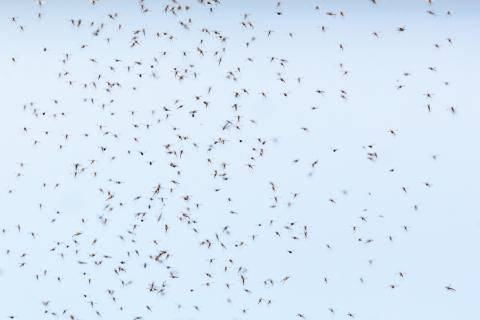Dengue is a mosquito-borne viral disease that is widespread in tropical and subtropical regions of the world. The disease is transmitted by Aedes mosquitoes, mainly the Aedes aegypti mosquito, which breed in urban or peri-urban environments. Although most cases are asymptomatic or present a self-limiting febrile illness, severe forms and deaths from dengue are described. There are four serologically distinct dengue viruses, and infection with one of them creates permanent protection against the same serotype but not against the others, so it is possible to have clinical dengue on more than one occasion.
In recent decades, the incidence of dengue has increased dramatically worldwide: about half of the world's population is now at risk. Cases reported to the World Health Organisation (WHO) have increased eightfold in the last decade, but the actual number of cases is far higher than reported, as many infections go undiagnosed. The reason for this increase is complex, influenced by global phenomena such as climate change and increasing urbanisation, which provide the conditions for continued transmission of infection.
A collective threat
There are global dengue control targets set out in the "Global Strategy for Dengue Prevention and Control 2021-2030" whose main objective, among others, is to reduce the dengue case fatality rate to 0 % by 2030. To achieve this goal, dengue must be recognised as a collective threat, which requires global collaboration to strengthen preparedness, prevention and control. As part of this strategy, 26 August is International Dengue Day to raise global awareness and prioritise preparedness in the fight against dengue.
Dengue must be recognised as a collective threat, requiring global collaboration to strengthen preparedness, prevention and control.
It is endemic in more than 100 tropical and subtropical countries - in Africa, the Americas, South-East Asia, the Eastern Mediterranean and the Western Pacific - with 70% of the global burden concentrated in Asia. In recent years we are witnessing an increase in its incidence and geographical spread. It is spreading in traditionally endemic regions, such as the Americas, where more than twice as many cases were reported in 2022 as in 2021, with an upward trend that has continued in the first half of 2023, linked to favourable weather conditions for mosquito proliferation.
Outbreaks in Europe
It is now starting to affect new areas, including Europe. Dengue is not endemic in continental Europe and the vast majority of cases are travellers returning infected from an endemic country. In areas of the continent where a mosquito capable of transmission (Aedes albopictus) has become established over the past two decades, initially travel-related cases can lead to local transmission of the virus, as evidenced by sporadic dengue events since 2010. In that year, local transmission was first reported in France and Croatia. Subsequently, transmission has been reported again in France (nine outbreaks between 2010 and 2022), in Italy (year 2020) and in Spain (outbreaks in 2018, 2019 and 2022).
Expansion outside historical areas of transmission, where the population - including healthcare workers - may be unaware of disease manifestations and where there is no prior immunity as they have never been exposed to the virus, adds a step to the overall public health risk.
Travel-related cases can lead to local transmission of the virus, as evidenced by sporadic dengue events since 2010.
Prevention efforts in affected regions should focus on surveillance and control of Aedes mosquitoes. Surveillance and vector control measures are useful to reduce transmission. At the individual level, communities should take personal protective measures to prevent bites (application of repellents, sleeping under mosquito nets, wearing long clothing, etc.).
Vaccines available
There is no specific treatment for dengue, but access to early and appropriate medical care reduces mortality rates from severe dengue. Currently available vaccines can also have a positive impact, although their availability in endemic countries is still very limited.
WHO does not recommend any restrictions on travel or trade with countries affected by the current dengue epidemics. Travellers to dengue areas should be well informed about the level of risk of the disease and about preventive measures against mosquitoes, as well as the need for medical attention in case of symptoms suggestive of dengue.
Recently, in December 2022, the European Medicines Agency (EMA) approved a new dengue vaccine that may help prevent the disease. In this non-endemic setting, Europe, it can be considered the first dengue vaccine for travellers, as it is not necessary for the traveller to have had the disease before. This prior infection demonstrated by the presence of measurable antibodies is the limitation of the first approved vaccine, in 2018, which was never marketed in Europe.





